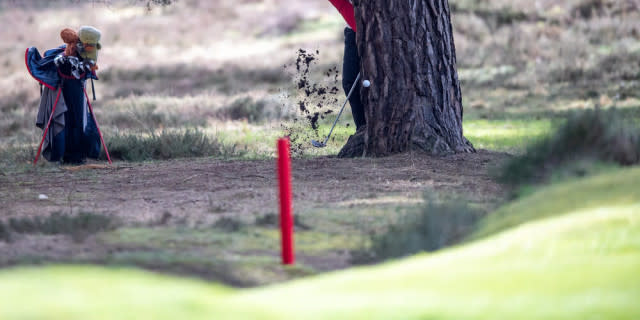
Changes to Augusta National For 2022 Masters
NOTHING ever stands still at Augusta National, with course changes becoming part of the tradition as the powers-that-be try to do their bit to tackle the distance debate.
And this year will be no different.
The par-4 11th - historically the second-hardest hole on the course - will now play to 520 yards after the tee was moved back by 15 yards and to the golfer’s left - most likely to bring the water into play more down the left side. It now plays 10 yards longer than the par-5 13th!
However, perhaps the biggest difference will be seen on the par-5 15th, which has been lengthened by an extra 20 yards to 550 yards. The new tee will almost certainly bring the water at the front of the green into play a lot more, which might even produce the same kind of drama we’ve seen on the 12th in recent years. Here’s hoping anyway!
The course will play to 7,510 yards, an increase of 35 yards compared to 2021. Intriguingly, 13 yards has also been added to the back of the 18th tee, though the official yardage remains the same at 465 yards.

Hole-by-Hole Guide
1st Tea Olive
Par 4, 445 yards
The first is a slight dogleg right that plays uphill. Drives to the left may catch the trees. The hole requires a precise second shot to a lightning-fast green that slopes from front to back. Players must avoid going beyond the flag with their approach.
2nd Pink Dogwood
Par 5, 575 yards
The second is a dogleg left which is easily reachable in two if you keep your drive on the fairway. Large, deep greenside bunkers demand special attention on the second shot.
3rd Flowering Peach
Par 4, 350 yards
A classic short par four that could be in reach for the likes of Bryson DeChambeau. Golfers attempt to hit short of the four fairway bunkers, resulting in a full shot to the green, where it is better to be long than short. The putting surface slopes right to left, with a thin neck on the left side guarded by a bunker.
4th Flowering Crab Apple
Par three, 240 yards
A brute of a par three that requires a long iron and is often made harder by deceptive winds. Two bunkers, front right and front left, guard the green, which slopes back to the front.
5th Magnolia
Par 4, 495 yards
An uphill, dogleg left to yet another sloping green. The fairway bunkers are deep and well positioned, demanding accuracy off the tee. To clear them requires a carry of 315 yards. The green slopes back to the front, and a rear bunker catches balls hit too long.
6th Juniper
Par three, 180 yards
This par three features an elevated tee and a large undulating green. The shifting levels of the putting surface from front to back make the pin position very important.
7th Pampas
Par 4, 450 yards
The ideal drive is to the left-centre of the fairway to set up a second shot from a level lie. From there, a short iron must avoid the three bunkers in front of the green and the two behind.
8th Yellow Jasmine
Par 5, 570 yards
An accurate drive is needed to avoid the fairway bunker on the right side on this uphill hole. The long, narrow green is bunkerless. It is guarded instead by a series of mounds, the biggest of which line its left side.
9th Carolina Cherry
Par 4, 460 yards
Huge green that slopes from back to front. Players often drive down the right side to avoid having to contend with two left greenside bunkers on their second shots.
10th Camellia
Par 4, 495 yards
This long downhill par four features a 60-yard-long bunker well short of the green. Players will try to drive the ball to the left for the best angle into a green that pitches right to left. Until 1935, this was the first hole. It is traditionally the most difficult hole on the course.
11th White Dogwood
Par 4 520 yards
The start of Amen Corner, and the hardest hole on the course, where wind is often a factor. The tee shot plays downhill and left to right. A pond guards the green to the left and a bunker is strategically placed to the right.
12th Golden Bell
Par 3, 155 yards
One of the world's most famous golf holes, this is Augusta National's shortest par three. Club selection is often difficult, as varying winds can require anything from a six-iron to a nine-iron. Rae's Creek and three strategically placed bunkers make it imperative that players hit the putting surface.
13th, Aazalea
Par 5, 510 yards
An accurate tee shot to this sweeping dogleg left allows players to go for the green in two. A tributary to Rae's Creek winds in front of the raised green, with four bunkers behind.
14th Chinese Fir
Par 4 440 yards
The primary defence is a terraced putting surface that drops significantly from left to right. Following a well-placed drive, the second shot will usually be a mid iron.
15th Firethorn
Par 5, 550 yards
A famously reachable par five. A well-struck second shot must be played over the pond and away from the bunker that guards the green on the right. Gene Sarazen hit his "shot heard 'round the world" here when he holed a four-wood approach from 235 yards away for an albatross in 1935.
16th Redbud
Par 3, 170 yards
This hole is played over water to a green secured by three bunkers. With the putting surface significantly pitched from right to left, an exacting tee shot is required to set up a birdie chance.
17th Nandina
Par 4, 440 yards
The putting surface at this uphill par four offers its share of challenges, as it seems to slope off in all directions. The back-right hole location is particularly demanding. The Eisenhower Tree - a pine named after the 34th president because he hit into it so often that he requested it be torn down - once stood just left of the fairway, 210 yards from the tee. An ice storm in 2014 caused irreparable damage to most of the tree's major limbs, resulting in its removal.
18th Holly
Par 4, 465 yards
One of the most famous finishing holes in golf, this uphill dogleg right is protected by two bunkers at the left elbow of the fairway. A drive hit down the centre will often require a middle iron for a second shot to a deep, narrow green guarded by one bunker short-left and another hard right.

Be part of the action with a selection of unique golf tournament experiences, from playing in a pro-am with the stars to watching the action at golf’s most illustrious events. Whether it’s the Masters or The Open, The Ryder Cup or WM Phoenix Open, build your own bespoke package with the experts at Golfbreaks.com.
What do you think? post your thoughts and feedback on the Golfshake Forum: https://forum.golfshake.com/
Tags: the masters PGA Tour Masters daily picks









